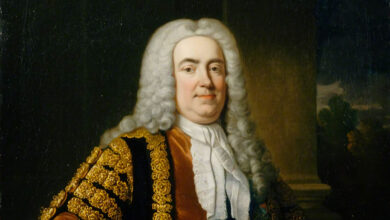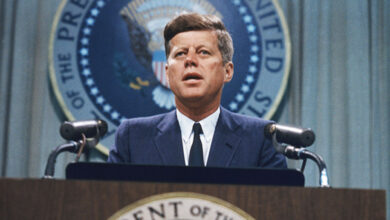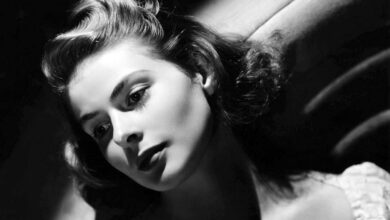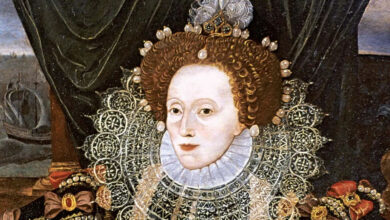Podcast: Play in new window | Download
Subscribe: Spotify | Amazon Music | Youtube Music | RSS
Lyndon Baines Johnson, known to most as LBJ, was born on 27 August 1908 in Gillespie County, Texas, USA. He was the eldest of five children born to a businessman, Sam Ealy Johnson and Rebekah Baines, who was the daughter of a prominent Texas state legislator.
Although the family struggled to make ends meet due to Sam losing money speculating on cotton, after graduating from high school in 1924, Lyndon enrolled at Southwest Texas State Teachers College which is now Texas State University. Whilst studying there he also took a teaching job at a Mexican American school in Cotulla.
LBJ graduated from college in 1930 and almost immediately got into politics as he helped the Democrat Richard Kleberg with his congressional election campaign. When the campaign was successful, he accompanied the new congressman to Washington, D.C. as his legislative assistant.
In 1934, at the age of 26, LBJ was introduced to Claudia Alta Taylor who had been known to everyone since childhood as Lady Bird. There was an instant attraction and on their first date at the Driskill Hotel in Austin, Texas, he proposed. The couple were married 10 weeks later on 17 November 1934 in San Antonio. Unfortunately, Lady Bird suffered three miscarriages, but the couple went on to have two daughters, Lynda Bird who was born in 1944 and Luci Baines who was born in 1947, meaning that Lyndon, Lady Bird and their two daughters all had the initials LBJ. The couple remained together until Lyndon’s death in 1973.
Back in Washington, LBJ began to associate with Sam Rayburn who became the Democratic leader of the House of Representatives, and this led to LBJ serving his next two years as the Director of the National Youth Administration in Texas, following which he successfully ran for a seat in the house on the back of President Franklin D. Roosevelt’s New Deal Policies. LBJ loyally served the constituents of his district for the next 12 years, although he had to take a break from his duties for six months during World War II, when he served as a lieutenant commander in the navy, becoming the first member of Congress to serve on active duty during the conflict. After he was almost shot down by Japanese fighters during an observation mission, he was awarded the silver star for gallantry by Gen. Douglas MacArthur.
Failing to win a seat in the United States Senate in 1941, LBJ ran again in 1948 and this time he won the Democratic primary and went on to serve in the Senate for the next 12 years. After the party regained the majority in 1955, Lyndon B. Johnson at the age of 46 became the youngest majority leader of the Democratic party in history. LBJ immediately set about reforming the Democratic party and set his eyes on the White House.
However, at the Democratic convention in 1960, the presidential nomination went to John F. Kennedy, but LBJ surprised many when he accepted Kennedy’s invitation to join the ticket as candidate for Vice President. It is thought that without LBJ’s support, Kennedy would never have carried Texas, Louisiana or the Carolinas and so would have been defeated by the Republican, Richard Nixon in the 1960 election, but as it turned out JFK was elected president and took office in 1961.
The role of Vice President didn’t work well for LBJ, and he constantly felt that the Kennedy administration was effectively ignoring him with Robert Kennedy, the Attorney General, even going as far as to call LBJ a “usurper in Kennedy’s Camelot”.
On 22 November 1963 however, everything changed, when Lee Harvey Oswald assassinated President Kennedy in Dallas. At 2.38 pm on the same day, Lyndon Baines Johnson took the oath of office whilst standing on board Air Force One becoming the 36th President of the United States. One of his first acts as Commander in Chief was to commission an investigation into the assassination of the president, which was led by the Chief Justice of the United States, Earl Warren. The Warren Commission ultimately concluded that there had been no conspiracy in JFK’s death.
On 27 November LBJ addressed a joint session of Congress and urged the passing of Kennedy’s legislative agenda, paying particular attention to the civil rights bill, which was finally passed in June, resulting in the Civil Rights Act being signed into law by Johnson on 2 July 1964. It was a profound piece of legislation, going a lot further than even Kennedy had planned. With its passing, racial segregation and discrimination in public places was prohibited, as was racial and sexual discrimination in employment.
At the University of Michigan in May 1964, LBJ had outlined his domestic agenda which he called the Great Society Program. It started with the Civil Rights Act, but more was to come including measures to fight poverty with new legislation establishing the Job Corps for the unemployed. The Voting Rights Act of 1965 abolished literacy tests and other tactics used to prevent African Americans from voting. Medicare which provided health benefits for the elderly and Medicaid which provided health benefits for the poor followed. The Great Society Program also tackled education, housing, transport, the environment, and immigration. When he was returned to office for a second term with more than 61 percent of the popular vote, LBJ felt that he had been given the mandate by the people to push his reforms forwards. However, all of this good work was tempered by the fact that the United States was becoming increasingly involved in the war in Vietnam which had already started to accelerate under Kennedy’s leadership.
In early August 1964, in the Gulf of Tonkin, U.S. destroyers were allegedly attacked by North Vietnamese gunboats. Two days later, LBJ was essentially given the authority by Congress to conduct all-out war in Vietnam although war was never formally declared. He almost immediately committed more troops to the area and in February 1965 he ordered massive bombing raids in the North of the country. By the end of the year over 180,000 military personnel had been deployed to Vietnam. By its peak in 1968, that number had risen to 550,000.
Consequently, American casualties started to increase, and with this, the President’s popularity started to decline. Student demonstrations against the war started in 1965 and this spread to other parts of the U.S. population and by 1968, many prominent political figures were calling for an end to the war.
What’s more, to pay for the war, a significant amount of money was being diverted away from The Great Society Program with the result that a large number of African Americans were still living in slums, were still unemployed and were still suffering from inadequate medical care, and so, discontent in the general population continued to grow.
The end of Lyndon B. Johnson’s presidency saw the assassination of Martin Luther King, race riots, the assassination of Robert F. Kennedy, and anti-war protestors engaging in battles in the street with the police, all of which was seen by millions on television.
After the Democrats lost the next election to Richard Nixon, Lyndon B. Johnson retired to his home, the LBJ Ranch in Texas where he settled down to write his memoirs.
Only four years later, on 22 January 1973, at the age of 64, he suffered a massive heart attack in his bedroom. He managed to call the Secret Service agents stationed at the ranch for help and he was airlifted to Brooke Army Medical Center where an Army colonel, Dr. George McGranahan pronounced him dead on arrival. The body of Lyndon B. Johnson lay in state at the U.S. Capitol before he was honoured with a state funeral, the final services for which took place on 25 January. He is buried in a private cemetery a few yards from the house in which he was born.
Podcast: Play in new window | Download
Subscribe: Spotify | Amazon Music | Youtube Music | RSS




